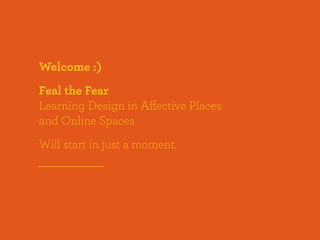
Feel the Fear: Learning Design in Affective Places and Online Spaces
- 1. Welcome :) Feal the Fear Learning Design in Affective Places and Online Spaces Will start in just a moment.
- 3. HELLO my name is I AM A
- 4. HELLO my name is I AM A
- 5. Feel the Fear: Learning Design in Affective Places and Online Spaces
- 6. Methodology I’ll start with a story…
- 10. Is fear important to design learning, and can you actually ‘catch’ it from a hallway?
- 11. af.fect (noun): to impress the mind or move the feelings of a person.
- 12. Graphic design teachers seek to develop a design eye in their students, a “feel” for design. This is a kind of informed taste and once established is tacit, a form of embodied knowledge.
- 15. Places and things are complicit in this process in particular: hallways.
- 18. If affect (and fear) and seeing the exemplar work of others, is important to the development of design students, then student bodies, and learning places—virtual or physical—take more importance than we may expect.
- 19. Methodology
- 23. ANT does not distinguish between human and non human, material or cultural (Arnseth, 2011). The social emerges from the myriad relations between human and non-human actors, no agency is given a priori.
- 24. In ANT a hallway has agency, but not intentionality.
- 25. ANT draws our attention to the associations: the work of translation, negotiation, and enrolment of actants—objects, people, and ideas— coming together (or not) in webs of relations termed actor-networks, or assemblages.
- 26. ANT allows us to analyze how the materiality of learning environments is implicated in the development of design students.
- 28. Non-Representational Theories focus on spaces, bodies, objects, activities and practices and affects—the ‘background hum’ of everyday life (Anderson & Harrison, 2010).
- 29. Our habits, dispositions, our ways of being in the world emerge from the multiple interactions—including affect—that make up the ‘world’ we inhabit (Nigel Thrift 2007).
- 30. There are many kinds of affects possible, many kinds of interactions, and many kinds of outcomes, and the material world has affordances that enable some, and prevent (or restricts) others (Thrift 2007).
- 31. Design education is socio-material, an assemblage of people, objects, ideas and spaces, combining (or not) in ways that produce effects: like a design eye.
- 32. Just describe — Bruno Latour (2005)
- 36. Literature
- 37. Affect is a slippery concept, often described using terms such as “forces” or “energies”, “intensities” and “shimmers” (Gregg and Seigworth 2010, 1)
- 39. shimmers
- 40. Psychobiological reading: affect is an object, human centered able to ‘leap’ between bodies, it is ‘contagious’ and capable of being ‘caught’ (Ahmed 2010, 39).
- 42. Post-structuralist notion: affect as contingent, but not necessarily connected with emotion within human bodies. Affect is capable of circulating around and through objects, spaces, ideas and people.
- 44. Bodies can also participate in affective relations with non-human things to produce learning.
- 45. Bodies can coexist with objects set-up for pedagogic purpose, that have the capability to affect them, and attune them “hitherto undetectable differences” (Latour 2004, 209).
- 47. Bodies and affect have a role in how we form taste — our likes and dislikes.
- 48. We move closer to the things we like and further away from the things we don’t like.
- 49. Affect can both ‘circulate’ and ‘stick’ to bodies and places (Gregg and Seigworth 2010, 1).
- 51. Touching can connect us to an object, this is preserved through hab- it (Ahmed 2010). ‘To be affected by something is to evaluate that thing’ (Ahmed 2010, 31)
- 52. The more time and interaction with an object the more chance there is that affect sticks to it and that we will begin to evaluate and pass judgment on it (Ahmed 2010, 29).
- 54. But why the ‘fear’ exactly?
- 55. Signature pedagogy (Shulman 2005) like graphic design pedagogy (Shreeve 2011), practice benchmarking which forces students to measure themselves against others (Shulman 2005).
- 57. Benchmarking encounters are commonly affective encounters (Shulman 2005)
- 58. Affect leaks (Massumi 2002), by means of exemplar student work…
- 60. The hallway is an affective benchmarking experience. Affect is the crucial ingredient helping students to ‘catch’ (Mulcahy 2011) the design eye.
- 64. We rely on others to form our taste (Hennion 2007). The Digital Wall does not allow the visitor to stand alongside others and be seen to be looking; it does not allow for the formation of taste in the presence of others.
- 65. ‘Liking’ demonstrates the possibilities inherent in online spaces to enable powerful connective experiences, leading to potentially generative learning.
- 68. The material world matters to learning design, and students need to see good work, and the work of their peers as much as possible.
- 69. To instil a design eye online may be a matter of engaging online students in a regular series of affective relations by making digital displays of student exemplar work ‘sticky.’
- 70. An online space must allow students to experience the virtual gaze of others, to form their taste in the presence of peers, professionals and teachers.
- 72. Thanks for Listening! Any Questions?
